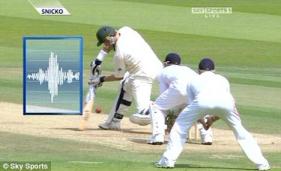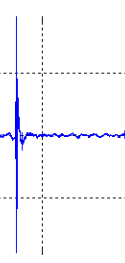How the snickometer works
One thing the cricket umpires at the Ashes will be doing this summer is listening. Did the ball clip the bat on the way through to being caught? Did the ball actually hit the pads meaning it isn’t caught out, but could be an LBW? This acute listening skill that cricketing umpires develop is mimicked in a piece of technology nicknamed snicko. The snickometer was invented in the 1990s by English computer scientist Alan Paskett. Although the umpires will not be using snicko for the Ashes this summer, broadcasters will be using it to review decisions. [1]
A microphone in the stumps picks up the sound and this is cleaned up to remove ambient noise by filtering. [2] What is displayed on the screen is what you might see on an oscilloscope or in a piece of music technology software. If the ball hits nothing, then the snicko graph shows nothing.
The two graphs here are some scientific measurements. [3] If the ball hits the bat (left graph), then the wood of the bat vibrates creating a clean sharp spike and a short sound is heard. If the pad or glove is hit, the impact is spread over a longer time, and with no wood to cleanly resonate the sound is usually intense (right graph). Where there is more than one sound, say if the bat also hits the ground, then synchronising the acoustic plots to slow-mo video replays can help reveal what the ball hit.
A simple bit of audio signal processing, it’s a shame it isn’t part of Umpire Decision Review System.
What is Real Time Snicko (RTS)?
With the Decision Review System (DRS) playing a major role in the Ashes, there are news reports about improving the technology. The old snickometer is slow because of a manual process needed to align video and audio; this is why it isn’t part of DRS. Real Time Snicko uses the same idea as Snicko but using a dedicated hardware system to automatically align picture and audio and so speed up the process. [4]
Notes
[1] http://tech.uk.msn.com/features/cricket-tech-the-technology-behind-the-ashes?page=4
[2] http://shashindrasri.blogspot.co.uk/2013/04/snickometer.html
[3] R. Rock, A. Als, P. Gibbs, C. Hunte, “The 5th Umpire: Cricket‟s Edge Detection System” Journal of Systemics, Cybernetics & Informatics;2013, Vol. 11 Issue 1, p4
[4] http://www.espncricinfo.com/ci/content/story/603632.html
Credits
Snicko photo: http://img.khelnama.com/sites/default/files/styles/large/public/snicko.jpg




